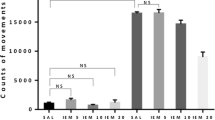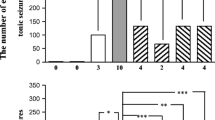Abstract
Twenty four hours after mice were forced to swim for up to 10 minutes in cold water, there was a reduction in the ability of MK-801 to antagonize the electrical precipitation of tonic hindlimb extension. Milacemide, a lipophilic prodrug of glycine, restored the antiseizure efficacy of MK-801 to the same level observed in unstressed animals treated with milacemide and MK-801. Stimulation of the glycine-gated chloride ionophore subsequent to the liberation of free glycine could explain milacemide's pharmacologic action as an adjuvant to MK-801. Consistent with this interpretation, milacemide was able to potentiate the antiseizure effects of flurazepam, a benzodiazepine agonist, in stressed and unstressed mice and carbamazepine in unstressed animals.d-cycloserine, a partial glycine agonist with greater specificity for the strychnine-insensitive modulatory site on the NMDA receptor complex, was examined for its effect on MK-801's antiseizure efficacy. At a high dose (320 mg/kg),d-cycloserine alone had an anticonvulsant effect. Moreover, this dose ofd-cycloserine administered with MK-801 showed a significantly greater anticonvulsant efficacy than MK-801 alone. The data support the development of glycinergic interventions as adjunctive agents in the pharmacotherapy of seizure disorders.
Similar content being viewed by others
References
Norris, D. O., Mastropaolo, J., O'Connor, D. A., Novitzki, M., and Deutsch, S.I. 1992. Glycinergic interventions potentiate the ability of MK-801 to raise the threshold voltage for tonic hindlimb extension in mice. Pharmacol. Biochem. Behavior. 43:609–612.
Dingledine, R., Myers, S. J., and Nicholas, R. A. 1990. Molecular biology of mammalian amino acid receptors. The FASEB Journal. 4:2636–2645.
Williams, K., Ramono, C., Dichter, M. A., and Molinoff, P. B. 1991. Modulation of the NMDA receptor by polyamines. Life Sci. 48:469–498.
Boje, K. M., and Skolnick, P. 1992. Ontogeny of glycine-enhanced [3H]MK-801 binding to N-methyl-d-aspartate receptor-coupled ion channels. Dev. Brain Res. 65:51–56.
Bakker, M. H. M., McKernan, R. M., Wong, E. H. F., and Foster, A. C. 1991. [3H]MK-801 binding to N-methyl-d-aspartate receptors solubilized from rat brain: effects of glycine site ligands, polyamines, ifenprodil, and desipramine. J. Neurochem. 57:39–45.
Deutsch, S. I., Rosse, R. B., Huntzinger, J. A., Novitzki, M. R., and Mastropaolo, J. Profound stress-induced alterations in flurazepam's antiseizure efficacy can be attenuated. Brain Res. 520:272–276.
Janssens de Varebeke, P., Cavalier, R., David-Remacle, M., and Youdim, M. B. H. 1988. Formation of the neurotransmitter glycine from the anticonvulsant milacemide is mediated by brain monoamine oxidase. British J Neurochem. 50:1011–1016.
Toth, E., and Lajtha, A. 1984. Glycine potentiates the action of some anticonvulsant drugs in some seizure models. Neurochem. Res. 12:1711–1718.
Peterson, S. L. 1986. Glycine potentiates the anticonvulsant action of diazepam and phenobarbital in kindled amygdaloid seizures in rats. Neuropharmacology. 25:1359–1363.
Peterson, S. L., Trzeciakowski, J. P., Frye, G. D., and Adams, H. R. 1990. Potentiation by glycine of anticonvulsant drugs in maximal electroshock seizures in rats. Neuropharmacology. 29:399–409.
Mastropaolo, J., Park, C.H., Norris, D. O., O'Connor, D. A., Lukacs, L. G., and Deutsch, S. I. 1992. Reduction of flurazepam's antiseizure efficacy persists after stress. Pharmacol. Biochem. Behav. 42:681–684.
Hood, W. F., Compton, R. P., and Monahan, J. B. 1989.d-Cycloserine: a ligand for the N-methyl-d-aspartate coupled glycine receptor has partial agonist characterists. Neurosci. Lett. 98:91–95.
Monahan, J. B., Handelmann, G. E., Hood, W. F., and Cordi, A. A. 1989. D-Cycloserine, a positive modulator of the N-methyl-D-aspartate receptor, enhances performance of learning tasks in rats. Pharmacol. Chem. Behav. 34:649–653.
Watson, G. B., Bolanowski, M. A., Baganoff, M. P., Deppler, C. C. L., and Lanthorn, T. H. 1990. D-Cycloserine acts as a partial agonist at the glycine modulatory site of the NMDA receptor expressed in xenopus oocytes. Brain Res. 510:158–160.
Foster, A. C., and Wong, E. H. F. 1987. The novel anticonvulsant MK-801 binds to the activated state of the N-methyl-D-aspartate receptor in rat brain. British J. Pharmacol. 91:403–409.
Schwartz, B. L., Hashtroudi, S., Herting, R. L., Handerson, H., and Deutsch, S. I. Gylcine prodrug facilitates memory retrieval in humans. Neurology. 41:1341–1343.
Author information
Authors and Affiliations
Rights and permissions
About this article
Cite this article
Norris, D.O., Mastropaolo, J., O'Connor, D.A. et al. A glycinergic intervention potentiates the antiseizure efficacies of MK-801, flurazepam, and carbamazepine. Neurochem Res 19, 161–165 (1994). https://doi.org/10.1007/BF00966811
Accepted:
Issue Date:
DOI: https://doi.org/10.1007/BF00966811




